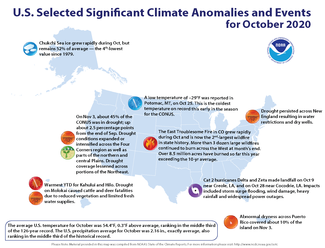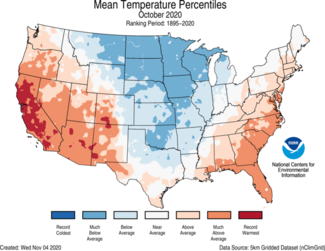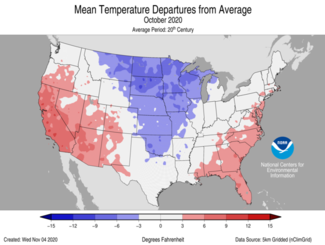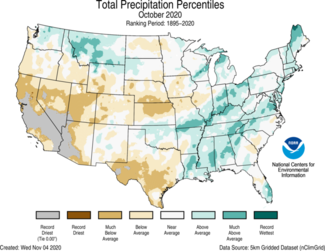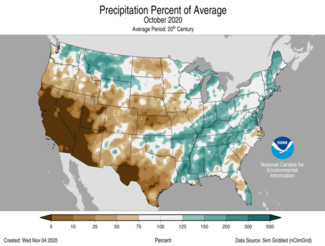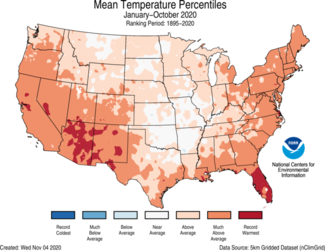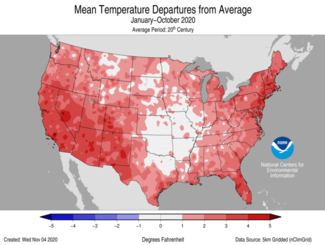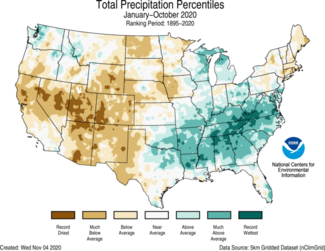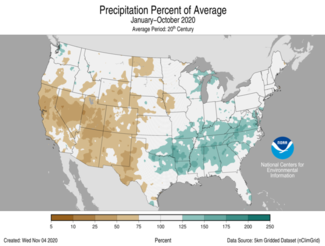Tie for most active Atlantic hurricane season on record; western wildfires continue to set new records

For October, the average contiguous U.S. temperature was 54.4°F, 0.3°F above the 20th-century average. This ranked in the middle third of the 126-year period of record. For the year-to-date, the contiguous U.S. average temperature was 57.0°F, 2.1°F above average, and tied with 2006 for seventh warmest in the historical record.
The October precipitation total for the contiguous U.S. was 2.16 inches, exactly average, and ranked in the middle third of the historical record. For the year-to-date, the contiguous U.S. precipitation total was 26.30 inches, 0.94 inch above average, and ranked in the wettest third of the January-October record.
Above-average tropical activity across the Atlantic Basin continued into October as one tropical storm and three hurricanes developed over the course of the month. With the formation of Tropical Storm Eta on November 1, 28 named storms have formed during 2020, which ties 2005 for the record number of storms in a single season.
Wildfires across Colorado grew rapidly during October. As of November 1, the three largest fires on record in Colorado occurred in 2020. More than three dozen large wildfires continued to burn across the West at month’s end. Over 8.5 million acres have burned so far this year, which exceeds the ten-year average.
This monthly summary from NOAA National Centers for Environmental Information is part of the suite of climate services NOAA provides to government, business, academia, and the public to support informed decision-making.
October Temperature
- Above-average temperatures dominated the western U.S., the central Gulf Coast and the East Coast. California ranked warmest on record for October while Arizona and Florida both ranked third warmest.
- Below-average temperatures were observed from the northern Rockies to Great Lakes and southward to the southern Plains. North Dakota, South Dakota, Minnesota, Iowa, Wisconsin and Oklahoma ranked among their 10 coldest Octobers on record.
- A deep trough of low pressure across the West during the last week of the month allowed unseasonably cold temperatures to plunge into portions of the Rockies, northern Plains and Great Lakes. Record to near-record cold temperatures blanketed the U.S. from the central and southern Rockies to the western Great Lakes during the last week of October. A number of records for cold daily high and low temperatures were broken.
- On October 25, Potomac, Montana, reported a low temperature of −29°F — the coldest temperature on record this early in the season for the contiguous U.S.
- Many stations throughout the Rockies reported below-zero temperatures on the early morning of October 26.
- Alaska ranked in the warmest third of the October record with a statewide average temperature of 29.0°F, 3.5°F above the long-term average. A strong northwest to southeast temperature anomaly gradient existed during October with the warmest anomalies across portions of the North Slope and the coolest across the Southeast Interior and the Panhandle. It was the fourth-warmest October for Utqiaġvik (Barrow) and the 19th consecutive such year-to-date period with above normal temperatures.
October Precipitation
- Below-average precipitation was observed across much of the western U.S., the Deep South, central and northern Plains as well as across portions of the Southeast. California ranked second driest on record for October. Nevada and Utah both ranked sixth-driest October on record.
- Above-average precipitation occurred across portions of the northern Rockies, Great Lakes, middle and lower Mississippi Valley, Ohio Valley, Northeast and parts of the Southeast.
- Record daily and monthly snowfall were reported across portions of the West and Plains during the last week of October.
- It was the snowiest October on record for many stations including Spokane, Washington (7.5 inches); Great Falls, Montana (28.0 inches); Minneapolis-St. Paul (9.3 inches) and St. Cloud, Minnesota (7.2 inches); Albuquerque, New Mexico (4.2 inches); Amarillo, Texas (7.4 inches) and Wichita, Kansas (1.6 inches).
- An ice storm associated with the record cold temperatures impacted parts of the central and southern Plains on October 27. More than 350,000 residents in central and southwestern Oklahoma were without power as freezing rain and ice brought down foliage-filled trees and, subsequently, powerlines. This is the earliest ice storm on record for Oklahoma.
- Across Alaska, October was wet across parts of the North Slope. The Panhandle and Gulf Coast were drier than average for the month.
- According to the November 3 U.S. Drought Monitor report, approximately 45 percent of the contiguous U.S. was in drought, up slightly from 42.6 percent at the end of September. Drought conditions intensified across the Four Corners region as well as parts of the northern and central Plains. Drought coverage became less severe across portions of the Northeast. Drought also expanded across Hawaii.
October Extremes
- Eleven named U.S. storm continental landfalls have occurred during the 2020 Atlantic hurricane season through November 1. This breaks the previous record of nine landfalls in 1916.
- Through November 1, six hurricanes made landfall in the U.S., which ties 1985 and 1886 for most hurricane landfalls in a single season.
- Hurricanes Delta and Zeta made landfall along the Louisiana coast during October, bringing the total number of landfalling named storms for Louisiana in 2020 through November 1 to five (Cristobal, Marco, Laura, Delta and Zeta). This is a new record for Louisiana and any U.S. state.
- Category 2 Hurricane Delta came ashore on October 9 at Creole, LA, six weeks after Category 4 Laura and approximately 12 miles east of Laura’s landfall location.
- As of November 3, Delta and Eta are the strongest Greek-named hurricanes in the Atlantic on record with maximum sustained winds of 145 mph, exceeding Beta (2005), which had 115 mph maximum sustained winds.
- Category 2 Hurricane Zeta made landfall near Cocodrie, LA, on October 28, joining Kate (1985) and two unnamed storms (1935, 1899) as the only Category 2 storms on record to make mainland U.S. landfall so late in the Atlantic season.
- More than 2.7 million customers from Louisiana to Virginia were without power on October 28 and 29. Widespread damage resulted from storm surge, high winds and flooding rainfall across much of the region as Zeta moved up the East Coast.
- Despite the record pace and tie for number of named storms in the Atlantic, the 2020 tropical cyclone Accumulated Cyclone Energy (ACE) is just barely in the top quartile, or above 165 percent of the 1981-2010 median value.
- The wildfires across Colorado continue to burn. As of November 1, the East Troublesome Fire is now the state’s second-largest wildfire on record with more than 193,000 acres consumed. In late October, the fire spread rapidly, forcing the evacuation of the entire town of Grand Lake. The 2020 Cameron Peak and Pine Gulch fires are currently the largest and third-largest fires in state history, respectively.
- Near the end of October, wildfire conditions and subsequent activity across California rekindled. Residents in parts of southern California had to evacuate due to dry conditions and strong Santa Ana winds. Nearly 100,000 Orange County residents were forced to evacuate as the Silverado and Blue Ridge fires spread rapidly. Reports of winds in excess of 100 mph were observed along several ridgetop ski resorts on October 25-26. High winds combined with very dry air and fuels created an ideal environment for explosive wildfire activity.
Year-to-date (January-October) Temperature
- Above-average year-to-date temperatures were observed across most of the Lower 48. Record warm temperatures were scattered throughout the Southwest and Southeast. Arizona, New Mexico and Florida ranked warmest on record for this 10-month period with six additional states in the West and Northeast ranking among their top-3 warmest January-Octobers on record.
- Near-average temperatures were observed from the northern Rockies to the central Plains. There were no notable regions reporting below-average temperatures for this year-to-date period.
- Temperatures across Alaska ranked in the middle third of the historical record for January-October. Above-average temperatures blanketed much of the West Coast and Aleutians as well as parts of the North Slope. Below-average temperatures were observed in portions of the Northeast and Southeast Interior regions.
Year-to-date (January-October) Precipitation
- Above-average January-October precipitation dominated much of the central Gulf Coast, Midwest, Southeast, Great Lakes and parts of the Northwest. Tennessee ranked wettest while North Carolina ranked second wettest for this year-to-date period.
- Below-average year-to-date precipitation occurred across the West, parts of the northern and central Plains as well as the Northeast. Utah ranked driest on record while Colorado ranked second driest.
- Across Alaska, year-to-date precipitation was near average. The Aleutians and Gulf Coast were drier than average while portions of the Interior regions received above-average precipitation for the first 10 months of the year.

